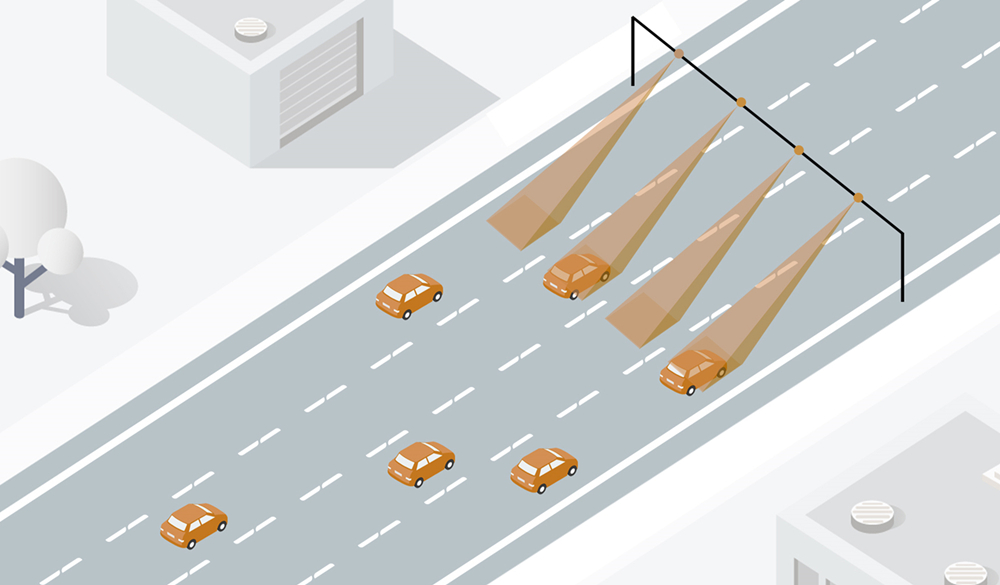The advantages of multi lane speed radar in law enforcement applications
With the acceleration of urbanization and the sharp increase in the number of motor vehicles, road traffic safety has become one of the important issues in urban management. In order to effectively manage and regulate traffic order, improve road safety and traffic efficiency, multi lane speed radar has gradually become an important component of intelligent transportation systems.
Save equipment costs
High integration, reducing the number of devices
One of the biggest advantages of multi lane speed radar is its highly integrated design. Traditional speed measuring equipment often requires the installation of independent speed measuring devices in each lane, resulting in a large number of devices and high costs. The multi lane speed radar system can cover multiple lanes through an integrated device, greatly reducing the number of required equipment. For example, a high-performance multi lane speed radar system can simultaneously monitor vehicles in up to six lanes, significantly reducing the purchase cost of equipment.
Multi functional integration, reducing additional investment
In addition to the basic speed measurement function, multi lane speed radar also has various additional functions, such as license plate recognition, vehicle classification, vehicle trajectory tracking, etc. These multifunctional integrated designs mean that users only need to invest in one set of equipment to meet multiple monitoring needs, without the need to purchase additional specialized equipment, further saving equipment costs.
Advanced technology and high cost performance
The multi lane speed radar adopts the latest radar technology, image processing technology, and data transmission technology to ensure high precision, stability, and reliability of the equipment. These technological advancements have significantly improved the cost-effectiveness ratio of devices, allowing users to achieve higher performance returns with less capital investment. For example, devices using millimeter wave radar technology can provide higher resolution and longer detection range, thereby enhancing the overall cost-effectiveness of the device.

Reduce maintenance costs
Modular design, easy to maintain
Multi lane speed radar systems typically adopt modular design, with each module being an independent unit. This design enables the equipment to quickly locate faults during maintenance and replace corresponding modules without affecting the normal operation of the entire system. This modular design not only simplifies maintenance processes and reduces downtime, but also lowers the risk of service interruptions caused by equipment failures.
Remote monitoring and diagnosis to reduce on-site services
The advanced multi lane speed radar system supports remote monitoring and diagnostic functions. Through Internet connection, background management personnel can view the equipment status in real time, and conduct remote debugging or software update when necessary. This method greatly reduces the number of times technical personnel need to be dispatched to the site, saving labor costs and improving maintenance efficiency.
Data analysis and reporting to optimize management decisions
In addition to the basic speed measurement function, the multi lane speed radar system can also collect a large amount of traffic data, including vehicle speed, flow, vehicle type distribution, etc. These data can be used to generate detailed traffic reports, helping traffic management departments better understand traffic conditions and make scientifically reasonable decisions based on them. In addition, by analyzing historical data, future traffic trends can be predicted, and measures can be taken in advance to optimize traffic management strategies.

Roadside installation convenience
Easy and fast installation
Multi lane speed radar systems are usually compact in size, lightweight, and have a simple and fast installation process. The device can be installed on streetlight poles, signal light posts, or other roadside facilities without occupying valuable road space. Compared to traditional installation methods, this approach reduces construction time and impact on normal traffic, and lowers installation costs.
Strong adaptability and wide applicability
The multi lane speed radar system has strong environmental adaptability and can be flexibly deployed on both urban main roads and rural roads. In addition, some advanced systems also have the ability to work at night and in adverse weather conditions, ensuring all-weather traffic monitoring effectiveness. This high adaptability enables the device to operate stably in various environments, improving its utilization rate.
Strong scalability, adaptable to future development
With the changing demand for transportation, multi lane speed radar systems can be expanded according to actual situations. Whether adding new detection points or upgrading the functionality of existing equipment, it can be completed smoothly without affecting the operation of the existing system. This flexible scalability not only meets current traffic management needs, but also leaves space for future development, ensuring the long-term investment value of the system.
Multi lane speed radar is gradually becoming an important tool in modern traffic law enforcement due to its advantages in saving equipment costs, reducing maintenance costs, and facilitating roadside installation. Through the application of this technology, not only can the efficiency of traffic management be effectively improved, but it can also provide strong support for building a safer and more orderly urban traffic environment. With the continuous advancement and improvement of technology, it can be foreseen that more advanced functions will be integrated into multi lane speed radar systems in the future, further enhancing their performance and application scope.
